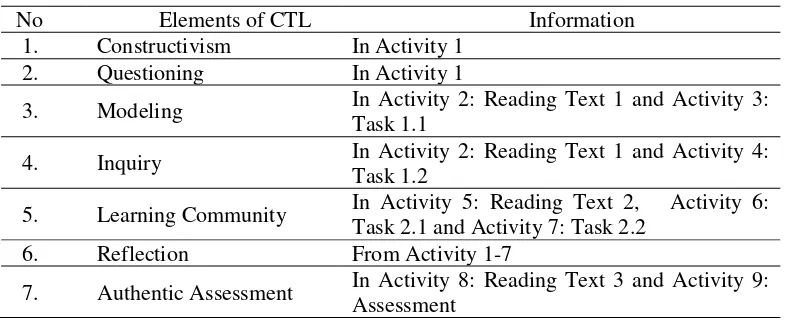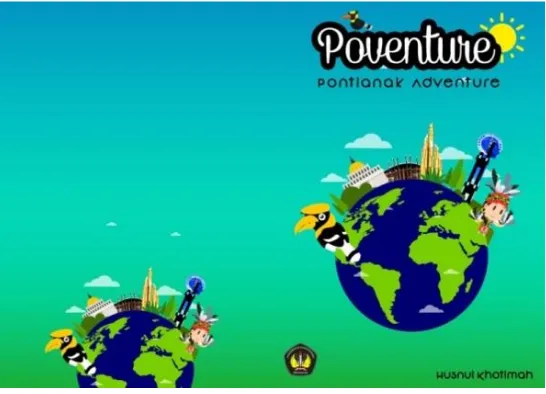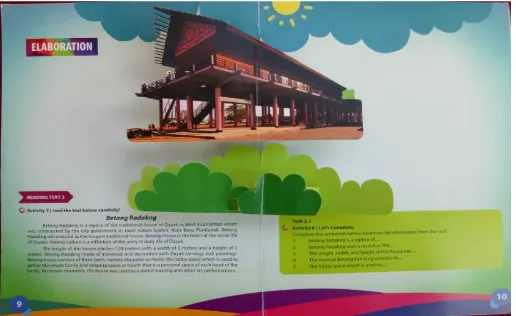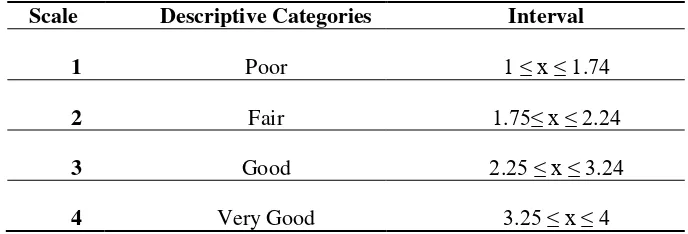1
DESIGNING POVENTURE AS SUPPLEMENTARY TEACHING MATERIAL
FOR TEACHING READING ON DESCRIPTIVE TEXT
Husnul Khotimah, Urai Salam, Eni Rosnija
English Education Study Program, Languages and Arts Education Department Teacher Training and Education Faculty of Tanjungpura University Pontianak
Email : [email protected]
Abstract
This research was conducted to design a teaching material needed by the teacher and students in reading on descriptive text to support CTL Approach. The material is called Poventure which is the abbreviation of Pontianak Adventure. The research was conducted at SMP Negeri 11 Pontianak with the eighth grade students in academic year 2016/2017 and their English teacher as the participants. The research applied R&D with three phases of development called ADDIE. From the need analysis, it was found that the students need interesting supplementary material to improve their reading comprehension on descriptive text. The research focused on creating the material to fit in the needs. In the research, the design of Poventure covered the concept of the product, while the development of Poventure described the contents and approach included in the product. To validate the product, an expert validation is used with the result of 3.75. This result meant that Poventure is a very good supplementary teaching material for teaching reading on descriptive text to support Contextual Teaching and Learning for grade eighth students at SMPN 11 Pontianak in academic year 2016/2017.
Keywords: Poventure, Descriptive Text, Reading, CTl, Development Research
INTRODUCTION
English is one of the major subjects that have to be mastered by students in junior high school. Most of the people in the world use English, not only as the communication but also as transferring knowledge. In learning English, there are four skills that have to be learned by the students. They are listening, speaking, reading and writing. Reading is one of skills which are very essential for each student. By reading, the readers can increase their understanding about the text or what they have read, enrich their vocabularies and knowledge.
In reading, it’s important to
comprehend the meaning of the text in order to catch the information and message. Based on the Curiculum Tingkat Satuan Pendidikan (KTSP) Depdikbud (2006), the second year students are expected to be able to understand and respond meaningful
written texts in term of functional written text and simple short essay in the form of descriptive and recount text interact with people in the nearest environment. There are many types of texts in reading, which are closely related to the purpose of each type. Descriptive text is one of the text types that taught at the second year of Junior High School.
Descriptive text has a social function is to describe a particular person, place, or thing, On the other hand, descriptive text has told description and identification of something, someplace or someone. It persuades the reader to imagine the text content.
2
first problem is the lack of materials provided by the teacher. In the teaching and learning process, the teacher uses the same textbook to teach the four skills. She seldom gives the students different kinds of reading passages. There is only one reading sources dominantly used by the teacher. The teacher used a textbook with title“English In Focus”. Moreover, the teacher explained that the students did not attract with the descriptive text because the text is not completed with pictures. Besides, the material that use by the teacher did not provide local content materials. The majority of materials in the book just focus on national culture contents.
Those problems above also effect the
students’ motivation of the reading
activities. The condition makes their interest of reading activities low. They are
found unfocused and bored on the teacher’s
explanation. Another problem is related to the reading comprehension of the students. Because of the lack of reading materials as their exposure and the low motivation in the reading activities, they found it difficult to comprehend English passages. They commonly found difficulties in getting the information in the text and also analyze the language features and schematic structures of descriptive text.
Considering the problem and also the lack of media sources used in SMP 11 Pontianak, the writer believed that the students need an interesting media as the alternatives to make reading more effective and efficient for the students. The writer decided to created attractive supplementary materials by combining 3D pictures or pop up and texts in one package. So, the writer decided to design a pop-up book with title
‘Poventure’ in teaching reading descriptive
for the eighth grade students of SMPN 11 Pontianak. Pop Up picture at the Poventure will give the student image and illustration which will help them to understand the content of the text and can help the teacher make the students more interest to the learn.
Moreover, in order to make supplementary materials become more easy
and better understanding in learning descriptive reading the writer decided to use Contextual Teaching and Learning (CTL). This approach is the most appropriate to be used as the basic of designing the teaching supplementary materials because Contextual Teaching and Learning Approach help students to make connections between knowledge and its applications to their lives. It will make the students understand and solve the problems, express and develop their ideas.
To sum up, this study aimed to produce English Supplementary Teaching Materials based on Contextual Teaching and Learning for the eighth grade students of SMP 11 Pontianak to help them develop their reading descriptive text. Furthermore, the pictures in the form of pop-up in Poventure can help the children understand the content of the story more easily and also this supplementary materials can be able to promote the local place of Pontianak.
METHOD
In carrying this research the writer used design and development research. Richey and Klein (2007:1) define design and
development as “the systematic study of
design, development, and evaluation processes with the aim of establishing an empirical basis for the creation of instructional and non-instructional products and tools and new or enhanced models that
govern their development”.
In designing the supplementary teaching materials the writer adopts ADDIE model and designed based on seven components of CTL approach. According to Branch (2009:1) ADDIE is an acronym for Analyze, Design, Develop, Implement, and Evaluate. Because of the limit of the writer, the implementation and evaluation phase are not apply in this research, so the writer only use ADD model which consist of Analyze, Design, and Develop.
Analyze
3
information. Here, the English teacher was the sources of the information. The reasons in conducting the interview is to findteacher’s opinion about the problem in the
classroom, information about what students need in learning reading descriptive text and to know the facilities for learning English in the school.
In analyzed the writer also considered five quality standards before designing supplementary teaching materials. They are the curriculum applied in the school, the syllabus used by the English teacher, the kind of books used, the types of learning and teaching activity based on the curriculum, and the roles of learners, teacher, and instructional materials based on the curriculum (Richards and Rodgers , needs analysis which is Analyze were used as guidelines in designing the supplementary teaching material for teaching reading descriptive text based on contextual teaching and learning for grade VIII at SMP 11 Pontianak. competence, learning objective, genre of text, grammar and tasks.
they are constructivism, inquiry, questioning, learning community, modeling, reflection, and authentic assessment. After develop the product, the writer asked an expert to evaluate the product in a form of assessment rubric to know whether the product is appropriate or not. The product was evaluated based on the content, layout, language, design and graphic so the strength or the weaknesses of the draft could be found.
RESEARCH FINDINGS AND
DISSCUSSION
The writer used ADD procedure to collect the data. By using this procedure, the writer also answered the research problems formulated step by step. It was useful to get clear explanations.
4
book, the descriptive text was from Indonesia and not provided with any approach. After checking the book which was used by the English teacher, the writer found that for reading the core competences were that students must understand the meaning and expression in descriptive text to interact with their social environment. In addition, the standard competences were that students in reading process must be able to read the text loudly and express and respond the meaning of the text to interact with their social environment.Although the descriptive text came from Indonesia, the teacher still hoped that the descriptive text came from the local as the suppelemetary materials for reading descriptive text.
To select the activity for students, in this curriculum, the English teacher must consider five things. First, the activity must provide opportunities to students to acquire and process knowledge themselves. Second, the activity must reflect in certain cognitive, psychomotor, and affective aspects. They were able to understand imaginative symbols and value of things around them. Furthermore, they were also able to see the relationship of characters and situation and able to respond the stimuli given. That is why the English teacher must active to be a model for the target language. In addition, the role of the teacher is developing teaching learning activity and materials which is assisted by instructional materials to enhance the students learning mastery.
After obtaining the data from the need analysis and deciding the media that would be designed. This process aimed at creating an teaching and learning material which can be used in the classroom. Designing was conducted after the need analysis. The result of the need analysis was used to design the supplementary material. The standard competences of the were taken from the KTSP 2006 Curriculum as the school was using that curriculum in the teaching and learning for eighth grade srudents. the writer designed the material based on the need analysis data, the result of the interview as well as the analysis of the observation.
In designing the supplementary materials the writer designed by following the standard competence in syllabus namely understand and respond meaningful written texts in term of functional written text and simple short essay in the form of descriptive interact with people in the nearest environment. It was designed to achieve learning objectives namely: (1) students are able to pronounce descriptive text by reading loudly using acceptable pronounciation, stress, and intonation, (2) students are able to identify the information in descriptive text, and (3) students are able to respond the meaning in descriptive text by answering questions accurately and acceptable.
The genre of the text in this supplementary material is decriptive text. There were 3 texts with 4 pop up picture that described the place of the local place provided in this supplementary material; the
first title is “Equator Monument”, the
second is “Betang Radakng”, and the third
is “Tugu Digulist”. In the process of
designing the writer decided to choose 3 famous local places in pontianak. The writer choose these local places because
they are familiar with student’s life which
5
Grammar was used to explain the construction of the sentence and how to make a good sentence based on the type of the expressions and texts given. Grammar was written in the language features component, because there were some characteristics used in sentences in every topic. Grammar that was used to be learnt was simple present tense.In designing process, the writer also put the tasks and also the assessment. There
were 4 tasks and 1 assessment. They were applied in the activity related teaching and learning activity in KTSP. The activity consists of three processes which called by ECC process namely exploration, elaboration and confirmation. For task 1.1 and task 1.2 were applied in exploration and task 2.1 and task 2.1 were in the process of elaboration. While for the assessment the writer put in last part. Here is the outline of Poventure design:
Table 1. The Outline of Poventure Design
No Aspects Information
1. Skill Mentioned: Reading Skill
2. Topic Mentioned: Pontianak Adventure
3. Standard Competence
Mentioned:1.1 understand and respond meaningful written texts in term of functional written text and simple short essay in the form of descriptive interact with people in the nearest environment 4. Learning Objective Mentioned: 3 Learning Objectives 5. Genre of Text Provided: Descriptive Text
6. Grammar Provided: Simple Present Tense
7. Tasks Provided: 4 tasks and 1 assessment
In the development phase, the writer developed the supplementary teaching material using CTL approach. There are seven elements of CTL which were used by the writer namely constructivism questioning,
modeling, inquiry, learning community, reflection and authentic assessment. The writer put these elements as the activities in Poventure as supplementary teaching
material. This is the student’s activity in
reading descriptive text material
Table 2. The outline of the Development of Poventure
No Elements of CTL Information
1. Constructivism In Activity 1
2. Questioning In Activity 1
3. Modeling In Activity 2: Reading Text 1 and Activity 3: Task 1.1
4. Inquiry In Activity 2: Reading Text 1 and Activity 4: Task 1.2
5. Learning Community In Activity 5: Reading Text 2, Activity 6: Task 2.1 and Activity 7: Task 2.2
6. Reflection From Activity 1-7
6
In developing the supplementary speaking materials based on contextual teaching and learning book, the writer used many attractive fonts, different colors, and pop up pictures to make the students enjoy in the teaching and learning process. Reading Supplementary materials on descriptive text was made based on contextual teaching and learning approach which used students contextual social daily life as the main theme of the book, and it helped the students in comprehending the skill more easier.Developing the Construction and Description of Poventure
The writer believed that designing an attractive cover of a book is also important
to get student’s attention to read the book.
In this case, the writer tried to put the important characters of the main topic in the Poventure to be presented in the cover. In this way, the writer hoped that the students will be interested to read the book more deeply. Furthermore, in designing the cover, the writer tried to represnt the identity of the product by adding some pictures of iconic place in Pontianak. The writer put on the logo of Tanjungpura University, title of the supplementary material and the name of the writer. The cover of the Poventure can be seen in the picture below.
Figure 1. Cover
Constructivism and Questioning could be found in the Activity 1 in part of exploration. Here the teacher tried to
construct the student’s opinion and
knowledge by asking them several question about the pictures related to the reading comprehension materials. Besides written in the Poventure, questioning can be done by the teacher spontaneously in the class to
activate student’s attention and stimulate
students responses.
Modelling still found in the step of exporation in Activity 2: Reading Text 1 and Activity 3: Task 1.1. In the element of modelling the teacher gives model how to read and find out the information. This was important because in order to comprehend the supplementary reading material better.
7
students had been given a text and true and false task.In learning community the students discuss and share with the other students because the result of learning was better gained if the students discuss and share with other students. In learning comunity, the writer provided Learning community in Activity 5: Reading Text 2, Activity 6:
Task 2.1 by ansering the question and Activity 7: Task 2.2 by matching the synonym. Poventure designed by the writer was in group forms, the students learnt and did the tasks with their friends. Picture
3
below is the example of the detail
information about the activity in learning
community.
Figure 2. Learning Community Activity
At the end of the activity there was a reflection which was created to know what the students have learnt from the Poventure book designed by the writer. In this part the writer provided indirect instruction to reflect what they had learnt from Activity 1 to 7. Besides written in the Poventure, reflection can be done by the teacher spontaneously in the class.
To know the result of teaching and learning activity, the writer provided authentic assessment in Activity 8: Reading Text 3 and Activity 9: Assessment. Here the teacher tries to asess students’s performance. Teacher asks the students to read the text and do some tasks related to the text. By doing these activities the teacher would like to see
the student’s progress in comprehending
information in the text.
8
Table 3. The Result of Assessment Rubric
The product was evaluated based on the content, presentation, language, media, and appearance so the strength or the weaknesses of the product can be found. The four aspects are evaluated through a Likert scales with the range of four options: strongly agree, agree, disagree and strongly disagree. The result of this assessment became the consideration in revising the material. The comment and suggestion from the expert were very important at improving the book.
In the assessment rubric, the writer provided 29 items which divided into five criteria. The first criterion provides the criteria of the appropriateness of the content.
There are ten items in this criterion. The second criterion provides the criteria of presentations and language aspects in material design which has five items. The third criterion is the criteria of media aspects which provided with seven items. The final criterion is the criteria of appearance aspects.
The writer analyzed the expert judgement
about Poventure by using mean score.
The data from expert judgement was
measured by using Mean and analyzed by
using formula proposed by Suharto
(2008) which is:
Mn = ∑ 𝑓𝑥 𝑁 Mn =15
4
...
(1)
Mn = 3,75Where: Mn= Mean ∑ 𝑓𝑥= Total core
N= Total Number of Data
According to the total score which is calculated by using the formula above, the writer obtained 3,75 as the result of the evaluation of the product. In order to know
the category of the score, the writer used a guideline from this calculation, the result can be determained according to the Table 4.
No Criteria Item Max Score Score
1 The appropriateness of the content
10 4 3,6
2 Presentations and language 5 4 3,4
3 Media aspects 7 4 4
4 Appearance aspects 7 4 4
9
Table 4. Data Conversion Table for Expert Judgment
Scale Descriptive Categories Interval
1 Poor 1 ≤ x ≤ 1.74
2 Fair 1.75≤ x ≤ 2.24
3 Good 2.25 ≤ x ≤ 3.24
4 Very Good 3.25 ≤ x ≤ 4
The total score that the writer obtained is 3,75. Based on the guideline in table 4 above, the score of 3,75 is in the criteria of
“Very Good” with the description of “Do Not Revised”. From the criteria, it can be
emphasized that the expert considers Poventure designed by the writer as a very good product and feasible to be used as supplementary teaching material for teaching reading on descriptive text to support CTL approach.
DISCUSSION
Seven elements of CTL Approach within the ELT material were the characteristics used by the writer to develop the product as supplementary teaching material for eighth grade students at SMPN 11 Pontianak in academic year 2016-2017. From the finding explained above, the processes of designing material of analysis, design, and development, phases had relationship with the research questions formulated.
From the analysis phase, the writer found that CTL Approach which was used to develop ELT materials had relationship with the curriculum used in MTs Al-Rahmah. The writer in developing ELT materials also provided the objectives of learning that were based on the syllabus for eighth grade students. Considering the activity within the process of teaching and learning and defining the roles of the teacher, students and instructional materials during teaching and process are the aspects that the writer did in designing ELT
materials. In fact, in the analysis phase of before designing ELT materials done the writer considered to complete the quality standards as given by Richards and Rodgers (2001, p. 24).
Based on the outline of designing process in the designing phase, the writer had already answered the research questions by checking the main aspects should be provided in designing ELT materials as mentioned in Widodo and Savova (2010, p. 152-154) namely skill, topic, standard competence, learning objective, genre of text, grammar or structure, and tasks.
From the outline of the development of Poventure in the development phase, the writer also had already checked the characteristics used to develop the materials namely elements of CTL Approach. Those seven elements of CTL approach were constructivism, questioning, modeling, inquiry, learning community, reflection, and authentic assessment.
10
CONCLUSION AND SUGGESTIONConclusion
Based on the result of the research, the writer believed that the research question of this research had been answered completely from analysis until development phase. In design and development phase, the writer also had completed some aspects of designing and characteristics of developing material. The aspects must be included in designing phase are related to skill, topic, standard competence, learning objective, genre of text, grammar or structure, and tasks. In development phase the writer completed the supplementary material with seven elements of CTL approach and after the supplementary teaching material was done the writer asked the expert to evaluate the final result of supplementary teaching material by using assessment rubric. The assessment rubric consists of five aspects with 29 questions. Based on the assessment rubric the writer found that the expert strongly agreed (3,75) that the supplementary material designed by the writer is feasible or appropriate to apply in SMPN 11 Pontianak for grade VIII students.
Suggestion
For a better result of this study, the writerr considers some suggestions which
based on the expert’s suggestion. It was
suggested that the English teacher needs to design and develop another English teaching material with different skill and genre of text to motivate the students to
learn English enthusiastically. It is necessary for English teacher to choose the topics for teaching material with interesting topics to be discussed and colorful picture. CTL approach is one of the approaches which can be used by the teacher in developing their teaching material for other language skill. Since the supplementary material is evaluated only by the expert, it will be better if the supplementary material also evaluated by conducting a try-out. It can give a better evaluation for the developed material.
REFERENCES
Branch, R. M. (2009). Instructional Design: The ADDIE Approach. New York: Springer.
Johnson, B. E. (2002). Contextual teaching and learning: why it is and why it is here to stay . California: Sage Publication Ltd.
Richards, a. R. (2001). Approaches and Methods in Language Teaching. Cambridge: Cambridge University Press. Richey, R. C., & Klein, J. D. (2007).
Design and Development Research. New Jersey:
Lawrence Erlbaum
Associated.




